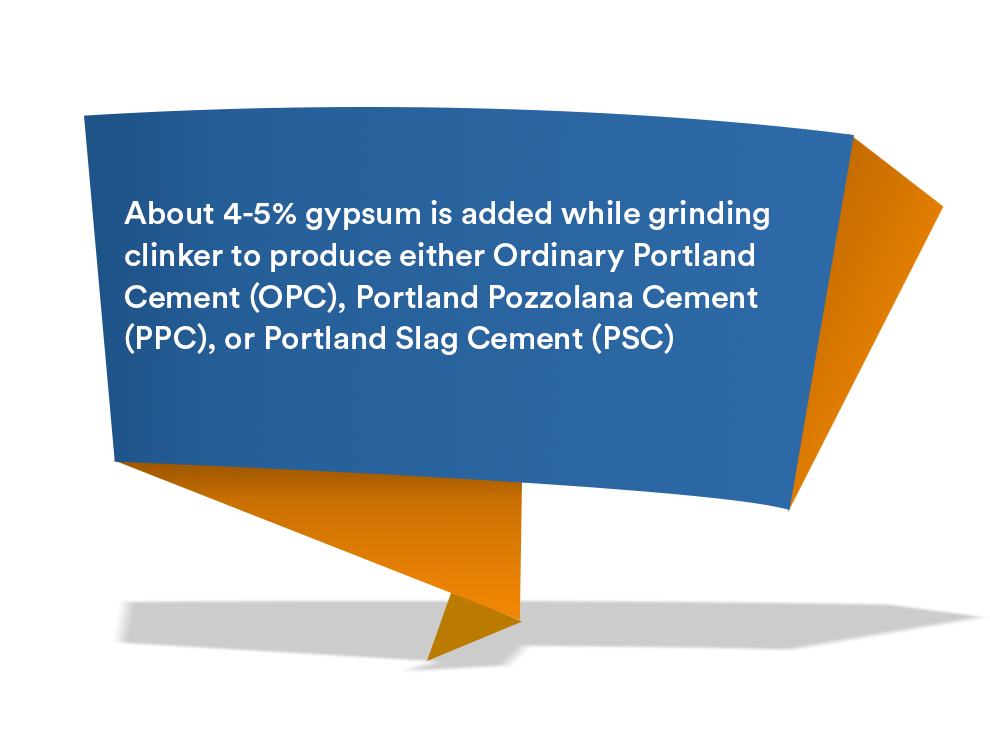Gypsum is an indispensable component of cement primarily utilised for regulating the setting time of cement or in other words the rate of hardening of cement. About 4-5% gypsum is added while grinding clinker to produce either Ordinary Portland Cement (OPC), Portland Pozzolana Cement (PPC), or Portland Slag Cement (PSC). The annual cement production in India during FY 2020-21 was about 334 MT, indicating a utilisation of about 13.3-17.0 MT of gypsum. Cement production is projected to increase to 491 million tonnes in the year 2024-25, which will call for increasing the gypsum requirement to 19.6–24.6 MT.
As water is added to cement, it forms a smooth paste, which remains plastic for a short time. As the reaction between water and cement continues, the plasticity of cement paste is lost and the paste solidifies. Tricalcium silicate is fast settling and is responsible for considerable initial strength in 2-7 days. While Dicalcium silicate settles slowly and becomes strong after a month of hydration. Tricalcium aluminate settles instantly in presence of water and provides internal strength of cement by filling the space in the lattice. Calcium Hydroxide binds the silicate participles together, while Aluminium Hydroxide fills the space in the lattice.
2CaO.SiO2 + x H2O→2CaO.SiO2 .xH2O
3CaO. Al2O3 + 6 H2O→3CaO. Al2O3 .6 H2O
3CaO.SiO2→2CaO.SiO2 + Ca (OH)2
3CaO. Al2O3 .6 H2O→3 Ca(OH)2 + 2 Al(OH)3
The addition of Gypsum allows plasticity and workability of the cement mixture by allowing adequate time for transportation, mixing and placement. When gypsum is added to the product, it reacts with tricalcium aluminate (C3A) to generate calcium sulfoaluminate hydrate (or ettringite), which forms a protection film on the cement particles to hinder the hydration of C3A and delay the setting time of cement.
3CaO. Al2O3 + 3CaSO4+ 2H2O→3CaO. Al2O3 .3CaSO4.2H2O
In addition to settling time, gypsum also acts as a coolant to bring down the heat of hydration and enables improved strength and hardness when compared to non-gypsum cement.
Considering the significant quantum of gypsum requirement, the Indian Cement Industry has been exploring alternative chemical sources of gypsum such as (a) Flue Gas Desulfurization (FGD)gypsum (a byproduct from the power industry), and (b) Phosphogypsum (a byproduct from fertiliser industry) to prolong the availability of natural gypsum. FGD gypsum is a byproduct of the desulphurisation process in coal based thermal power plants, Phosphogypsum is a byproduct created during the manufacturing of phosphoric acid. Phosphogypsum generation in India at various fertilizer plants is estimated to be 8.46 million tonnes per annum (2020-21). Due to the shortage of quality gypsum production in India, 5-6 MT of mineral gypsum is being imported from countries like Oman, UAE, Iran, and Bhutan. There are two critical aspects to foster the utilisation of chemical gypsum in the Cement Industry as detailed below:
Naturally occurring mineral gypsum is high purity material and is readily usable in the cement manufacturing purposes. Contrary to this, chemical gypsum has wide ranging chemical impurities along with high moisture content, which makes it unfit for direct use in cement manufacturing. Table 1 details the acceptable threshold limit of key quality parameters present in chemical gypsum.
| Parameter | Acceptable level(s) |
|---|---|
| Purity, % | Above 80 |
| Impurities | |
| pH on 5% water extract | >4.0 |
| Total Phosphorus as P2O5, % | <1 |
| Water soluble P2O5, % | <0.25 |
| Free Moisture, % | <15.0 |
Railway is the preferred medium of transportation for raw materials for the Cement Industry due to the large consignment size. Gypsum is currently classified at a high freight rate (Class 150) making it not so economical for the Cement Industry to move gypsum at various end use plants. The current tariff levels of industrial byproducts should be revised should be revised to lower freight slab to streamline movement to end user industries. Another important aspect to note is that gypsum by nature is a sticky material. Unloading of gypsum, therefore, takes more time than other materials such as clinker. A lower freight category would help limit demurrage charges at the goods sheds reducing the landed cost of procuring gypsum.
The Cement Industry offers significant opportunities for the utilisation of industrial gypsum byproducts. It is, however, critical to ensure that the chemical gypsum is pretreated to the required threshold limits. Moreover, recognition of the Polluter Pays Principal is recommended to promote even better circularity in gypsum utilisation.
